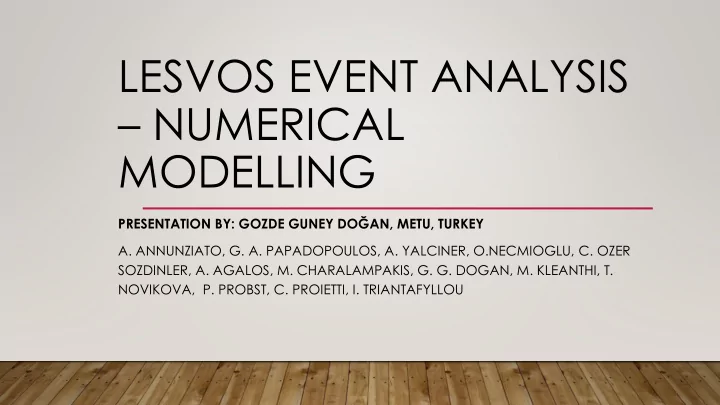

LESVOS EVENT ANALYSIS – NUMERICAL MODELLING PRESENTATION BY: GOZDE GUNEY DOĞAN , METU, TURKEY A. ANNUNZIATO, G. Α. PAPADOPOULOS, A. YALCINER, O.NECMIOGLU, C. OZER SOZDINLER, A. AGALOS, M. CHARALAMPAKIS, G. G. DOGAN, M. KLEANTHI, T. NOVIKOVA, P. PROBST, C. PROIETTI, I. TRIANTAFYLLOU
INTRODUCTION • On 12 June 2017 at 12:28 UTC a strong earthquake of Moment Magnitude Μw 6.3 occurred in between Lesvos and Karaada islands. • As well as Lesvos and Plomari, tsunami effected other islands nearby and on the coasts of western Turkey. • From eyewitness accounts, video records and photos, we have observations on Karaburun and Foca regions in Turkey. • The tide-gauge on Bozcaada Island, located more than 100 km from the epicentre, detected the arrival of the waves about 1 h after the event showing sea level change of a few cm. • As METU, we conducted several numerical modelling works.
OBSERVATIO N POINTS Bozcaada Bozcaada Foca Karaburu n
OBSERVATIO N POINTS Bozcaada Karaburun Yeniliman Foca Karaburu n
OBSERVATIO N POINTS Bozcaada Foca Foca Karaburu n
VISUAL OBSERVATIONS KARABURUN 40 min after the earthquake
VISUAL OBSERVATIONS FOCA
VISUAL OBSERVATIONS FOCA
NUMERICAL MODELING BY METU NAMI DANCE • Tsunami Numerical Model NAMI DANCE in GPU Environment • NAMI DANCE: Solves Nonlinear Shallow Water Equations (NLSWE) with a bottom friction term using the Leap-Frog numerical scheme • The 1km x 1km Finite Fault Model proposed by NOA is used as the tsunami source in the calculations. NAMI DANCE Propagatio Time history of water surface n fluctuations Coastal Input tsunami Defined Rupture amplification source Pre-determined wave Inundation form
NUMERICAL MODELING BY METU NAMI DANCE
NUMERICAL MODELING BY METU STUDY DOMAIN, TSUNAMI SOURCE AND OBSERVATION POINTS
NUMERICAL MODELING BY METU COORDINATES AND WATER DEPTHS AT OBSERVATION POINTS Observation Longitude Latitude Water depth in Point (degree) (degree) bathymetry file (m) Plomari harbor 26.3700474E 38.9730774N 1.95 Karaburun 26.4372631E 38.6711561N 1.56 Yeniliman Foca 26.7405112E 38.6650331N 1.71
Distribution of Maximum Water Elevations Computed by 60min Simulations
Distribution of Maximum Current Velocities Computed by 60min Simulations
NUMERICAL MODELING RESULTS Current (m/s) Time History of Water Elevations at Plomari Harbor Time History of Current Velocities at Plomari Harbor
NUMERICAL MODELING RESULTS Current (m/s) Time History of Water Elevations at Karaburun Yeniliman Time History of Current Velocities at Karaburun Yeniliman
NUMERICAL MODELING RESULTS Current (m/s) Time History of Water Elevations at Foca Time History of Current Velocities at Foca
NUMERICAL MODELING RESULTS Bozcaada Time History of Current Velocities at Bozcaada Time History of Water Elevations at Bozcaada
COMPARISONS AND DISCUSSIONS
COMPARISONS AND DISCUSSIONS
COMPARISONS AND DISCUSSIONS
DISCUSSIONS • There are some critical points (Candarli, Aliaga, Bademli and Dikili ) where water level elevations increase more than other locations. The observation points (Foca, Karaburun Yeniliman and Plomari Harbor) are among those locations. • There are some deviations of the numerical results from the observations which may be caused by internal errors of the numerical modelling process, the errors in estimation of the tsunami source or due to the bathymetry data. • In small events, like this Lesvos event, the numerical modelling process requires more precise work and the deviations of the numerical estimations may be higher. • It can be said that, for this case, the numerical models are quite able to estimate the arrival time or the wave periods and the different models are mostly in agreement in the trend of the waves.
THANK YOU!
Recommend
More recommend